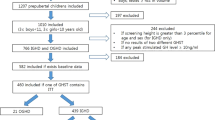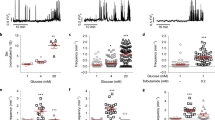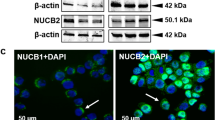Abstract
OBJECTIVE: To evaluate the maximal secretory capacity of somatotrope cells in obesity and to compare it with that in hypopituitaric patients with GH deficiency. DESIGN: Stimulation with GHRH. (1 μg/kg iv) combined with arginine (ARG, 0.5 g/kg iv), which strongly potentiates the GH response to the neurohormone, likely inhibiting hypothalamic somatostatin. The reproducibility of the GH response to GHRH+ARG was evaluated in a second session. SUBJECTS: Forty-five patients with simple obesity (OB 11 male and 34 female, age 40.5±1.8 y, BMI 38.8±1.1 kg/m2), 49 patients with hypopituitarism (GHD, 23 male and 26 female, 43.6±2.4 y, 24.7±0.7 kg/m2) and 44 normal young volunteers (NS, 25 male and 19 female, 33.8±1.0 y, 21.6±0.3 kg/m2) were studied. MEASUREMENTS: GH levels were assayed by IRMA method, basally at −60 and 0 min, and than every 15 min up to +120 min. Basal IGF–I levels were assayed by RIA method, after acid-ethanol extraction. RESULTS: IGF–I levels in OB were lower (P<0.005) than those in NS but higher (P<0.005) than those in GHD. Mean peak GH response to GHRH+ARG in OB was clearly lower than that in NS (P<0.005) and higher (P<0.005) than that in GHD. Sixty–percent OB and 100% GHD showed peak GH responses lower than the minimum normal limit in NS (16.5 μg/l) while 4% OB and only 53% GHD with GH responses lower than 3 μg/l, the limit under which GH replacement therapy of severe deficiency is allowed. Good intraindividual reproducibility of the GH response to GHRH+arginine test was present in all groups (OB: r=0.78, P<0.0001; GHD: r=0.57, P<0.003; NS: r=0.74, P<0.0001;. CONCLUSIONS: The maximal secretory capacity of somatotrope cells is clearly less than normal in the obese but still more than is seen in GHD subjects. However, in about 50% of obese patients, the pituitary GH releasable pool overlaps with that of hypopituitaric patients with GH deficiency. Thus, even when the maximal secretory capacity of somatotrope cells is evaluated by a potent and reproducible provocative tests such as GHRH+arginine, overweight has to be taken in a great account as the cause of severely impaired GH response in patients with suspected GH deficiency.
This is a preview of subscription content, access via your institution
Access options
Subscribe to this journal
Receive 12 print issues and online access
$259.00 per year
only $21.58 per issue
Buy this article
- Purchase on Springer Link
- Instant access to full article PDF
Prices may be subject to local taxes which are calculated during checkout
Similar content being viewed by others
Author information
Authors and Affiliations
Rights and permissions
About this article
Cite this article
Maccario, M., Valetto, M., Savio, P. et al. Maximal secretory capacity of somatotrope cells in obesity: comparison with GH deficiency. Int J Obes 21, 27–32 (1997). https://doi.org/10.1038/sj.ijo.0800356
Accepted:
Issue Date:
DOI: https://doi.org/10.1038/sj.ijo.0800356
Keywords
This article is cited by
-
GHRH + arginine test and body mass index: do we need to review diagnostic criteria for GH deficiency?
Journal of Endocrinological Investigation (2023)
-
Preoperative Prediction of Growth Hormone (GH)/Insulin-Like Growth Factor-1 (IGF-1) Axis Modification and Postoperative Changes in Candidates for Bariatric Surgery
Obesity Surgery (2013)
-
Serum Insulin-Like Growth Factor-1 Concentrations Are Reduced in Severely Obese Women and Raise After Weight Loss Induced by Laparoscopic Adjustable Gastric Banding
Obesity Surgery (2012)
-
Effects of short-term treatment with orlistat on growth hormone/insulin-like growth factor-I axis in obese post-menopausal women
Journal of Endocrinological Investigation (2011)
-
Prevalence of the metabolic syndrome in moderately-severely obese subjects with and without growth hormone deficiency
Journal of Endocrinological Investigation (2010)



